Driving just off Highway 64, the road turns rural and winding, running flat against open fields and old farm homes. It feels, in many ways, that the road is taking you nowhere–until the car turns left around a wide bend and suddenly catapults you into the cultur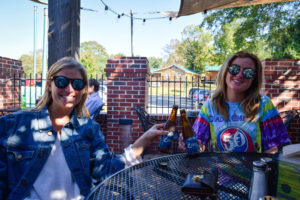 al oasis that is Saxapahaw, North Carolina. For tow n locals, as well as residents of Chapel Hill and Burlington in search of a liberal community, Saxapahaw provides a transport away from daily life. For Amidst a historical brick complex consisting of a local brewery, butchery, The Eddy Restaurant and Pub, and the Haw River Ballroom, there lies today’s destination: a yellow and red gas station and one-room general store.
al oasis that is Saxapahaw, North Carolina. For tow n locals, as well as residents of Chapel Hill and Burlington in search of a liberal community, Saxapahaw provides a transport away from daily life. For Amidst a historical brick complex consisting of a local brewery, butchery, The Eddy Restaurant and Pub, and the Haw River Ballroom, there lies today’s destination: a yellow and red gas station and one-room general store.
The Saxapahaw General Store is even more than its slogan: “Your local five-star gas station.” While there are gas pumps outside–located at a cross section of the Saxapahaw Museum and the Hawbridge School–a fuel-up is not typically the primary draw for customers. Upon entering what might otherwise look like a typical brick-plaza exterior, visitors quickly realize the niche experience that the General Store has to offer. One might not even notice upon first glance that the store doubles as a restaurant, as the eye moves across the unique and ec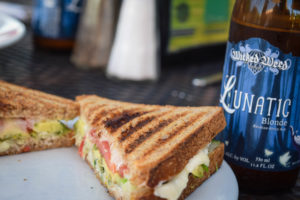 lectic expanse of merchandise. The three aisles in the store include a nice selection of local and nonlocal wines, beers, and kombucha; select grocery items such as pet food; and a plethora of artisan goods–ranging from organic name-brand snacks, to homemade chocolates, to all-natural soy candles and homeopathic lotions, oils, and hair products. The display of local products is frequently rotated, featuring different self-made t-shirts, hand-knit mittens, or personalized keychains. Despite artisan prices, it is easy to find small treasures that are special and worth the purchase.
lectic expanse of merchandise. The three aisles in the store include a nice selection of local and nonlocal wines, beers, and kombucha; select grocery items such as pet food; and a plethora of artisan goods–ranging from organic name-brand snacks, to homemade chocolates, to all-natural soy candles and homeopathic lotions, oils, and hair products. The display of local products is frequently rotated, featuring different self-made t-shirts, hand-knit mittens, or personalized keychains. Despite artisan prices, it is easy to find small treasures that are special and worth the purchase.
Beside the aisles of shelves is an open seating area consisting of a series of booths and a long communal table. This is where restaurant patrons indulge in one of the many well-loved General Store menu items. The kitchen itself is visible from the counter where custom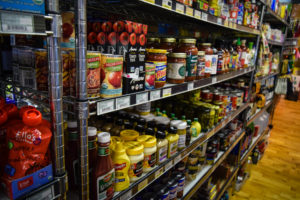 ers place their orders, built into view as part of the minimalist and transparent cuisine mission. If eaters come to dine on a sunny North Carolina day, they may eat outside on the terrace beneath vine-covered pergolas, sharing a bottle of wine or old-fashioned sodas while they wait for their server to bring out their meals.
ers place their orders, built into view as part of the minimalist and transparent cuisine mission. If eaters come to dine on a sunny North Carolina day, they may eat outside on the terrace beneath vine-covered pergolas, sharing a bottle of wine or old-fashioned sodas while they wait for their server to bring out their meals.
The General Store menu is diverse, as well as reasonably priced taking into account the restaurant’s commitment to use farm-to-table and local ingredients whenever possible. By partnering with local farms, such as Benevolence Farm and the Saxapahaw butchery, all of the General Store’s food tastes fresh and (typically) healthy. The store serves breakfast, lunch, and dinner Monday through Friday, adding a special brunch menu for Saturday and Sunday mornings. This includes specialties such as the “Eggs Parma: two toasted English muffins beneath thick slabs of mozzarella cheese, two eggs of your choice, and topped with a light tomato sauce, reminiscent of a vodka sauce-gone-breakfast.”
The daily menu, while large, is punctuated by customer favorites. Catering to the bohemian traffic and atmosphere within the restaurant, the General Store offers a myriad of vegetarian, vegan, and gluten-free options. Some favorites include the Avocado-Mater sandwich, which includes avocado, veggies, and cream cheese on multigrain bread; the eggplant parm sandwich combats its typical reputation by being both light and flavorful; the vegetarian pad Thai made specially in house with a secret ingredient; and show-stopping sides such as the garlic-y brussels sprouts and mashed rosemary sweet potatoes. Even the omelets, filled with your choice of additional components–(suggestion: roasted vegetables, fresh tomato, and avocado)–set themselves apart from the meals of most breakfast joints. While the General Store seems to thrive on cooking simply and with the right combination of ingredients, it is this flavor that builds a unique and satisfying experience. Other favorites for meat-eaters include the brisket sandwich and duck fries, potato skins friend in duck fat. The Store also serves full dinners and offers many specials, written daily on the chalkboards by the counter.
In essence, the Saxapahaw General Store facilitates an experience that marries simplicity and indulgence. The order-counter, farm-to-table cooking, three-aisle merchandise, communal tables, and gas station setting brings a casual tone that welcomes any and all visitors. Yet an alternative atmos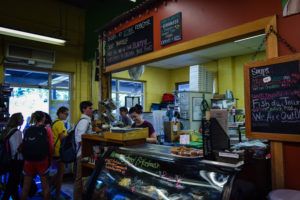 phere–from the people, to the artisan goods–allows customers to feel like they are on a quick vacation from the typical Piedmont North Carolina lifestyle. The General Store warrants a strong recommendation to visit for those who want to diversify their impression of North Carolina culture and who wouldn’t mind a short, worthwhile detour off Highway 64.
phere–from the people, to the artisan goods–allows customers to feel like they are on a quick vacation from the typical Piedmont North Carolina lifestyle. The General Store warrants a strong recommendation to visit for those who want to diversify their impression of North Carolina culture and who wouldn’t mind a short, worthwhile detour off Highway 64.

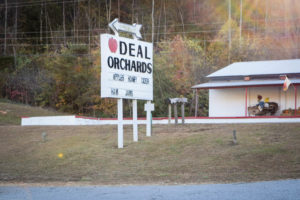 ous about how Northern eyes saw his little piece of North Carolina, prioritizing a good impression of a place he clearly took pride in. In fact, Taylorsville had been, he said, the capital of the American apple industry for decades, which his great-grandfather had a hand in.
ous about how Northern eyes saw his little piece of North Carolina, prioritizing a good impression of a place he clearly took pride in. In fact, Taylorsville had been, he said, the capital of the American apple industry for decades, which his great-grandfather had a hand in.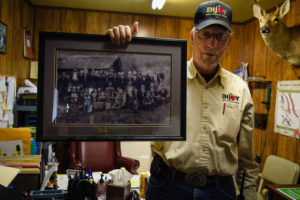 out, some of whom wore farmer’s overalls, and two of whom sported bushy white beards. The entire scene, set outside on an agricultural property, looked like it could have been torn from a Civil War history book. One of the two white-bearded men, however, was Lindsey’s great-grandfather–the original Deal’s Apples. The photo is of the first North Carolina Apple Growers’ Association, a group established to align NC apple farmers to compete and cooperate with larger wholesale produce markets. While Lindsey’s great-grandfather chose to partake in this industry, his brother (Lindsey’s great-uncle) chose to start a hardware store. Many will recognize it today as Lowe’s Home Improvement. Now onto the sixth-generation of apple Deal’s, Lindsey’s daughter left her job working numbers at Lowe’s to help run Deal’s Orchard with Lindsey’s other son.
out, some of whom wore farmer’s overalls, and two of whom sported bushy white beards. The entire scene, set outside on an agricultural property, looked like it could have been torn from a Civil War history book. One of the two white-bearded men, however, was Lindsey’s great-grandfather–the original Deal’s Apples. The photo is of the first North Carolina Apple Growers’ Association, a group established to align NC apple farmers to compete and cooperate with larger wholesale produce markets. While Lindsey’s great-grandfather chose to partake in this industry, his brother (Lindsey’s great-uncle) chose to start a hardware store. Many will recognize it today as Lowe’s Home Improvement. Now onto the sixth-generation of apple Deal’s, Lindsey’s daughter left her job working numbers at Lowe’s to help run Deal’s Orchard with Lindsey’s other son.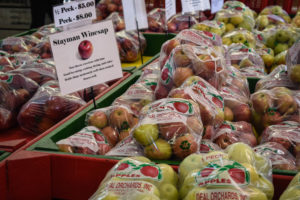 to deer hunters. These were Bushy Mountain Limbertwigs– native to the region and the very apple that his great-grandfather grew to found Deal Orchards. He picked up one apple and offered a bite to anyone with “good teeth.” The consistency was firm, difficult to chew, but flavorfully balanced between tart and sweet. He took another apple and placed it on the ground, proceeding to step and place his entire weight on it. Then he picked up the apple again to reveal that there were no dents or bruises.
to deer hunters. These were Bushy Mountain Limbertwigs– native to the region and the very apple that his great-grandfather grew to found Deal Orchards. He picked up one apple and offered a bite to anyone with “good teeth.” The consistency was firm, difficult to chew, but flavorfully balanced between tart and sweet. He took another apple and placed it on the ground, proceeding to step and place his entire weight on it. Then he picked up the apple again to reveal that there were no dents or bruises.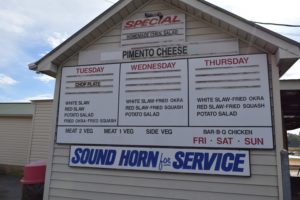 there be so much argument about barbeque?
there be so much argument about barbeque? 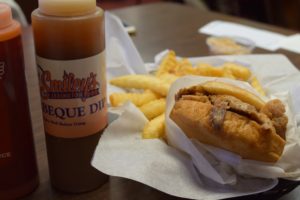 all of Lexington, North Carolina.
all of Lexington, North Carolina. 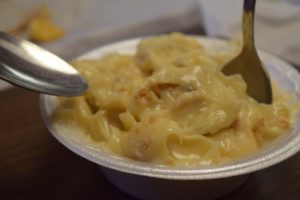 capital of the world,” said James Romoser, a reporter for the paper. “And for the people who prepare the meat, it means that the days before Christmas are a sleepless marathon of cooking over a smoky barbecue pit.”
capital of the world,” said James Romoser, a reporter for the paper. “And for the people who prepare the meat, it means that the days before Christmas are a sleepless marathon of cooking over a smoky barbecue pit.”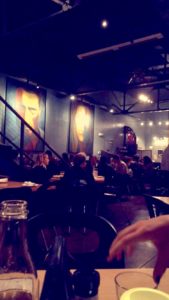 native to the usual bar we had become accustomed to college towns. The bar describes themselves as “
native to the usual bar we had become accustomed to college towns. The bar describes themselves as “ ndmade in the early morning and served up until dinner time. The produce and cheeses are outsourced as locally as possible, giving business to the booming farms of local Hendersonville.
ndmade in the early morning and served up until dinner time. The produce and cheeses are outsourced as locally as possible, giving business to the booming farms of local Hendersonville. 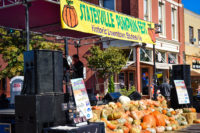
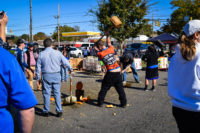
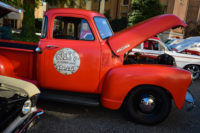
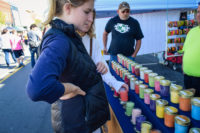


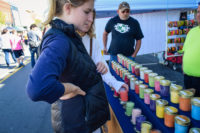
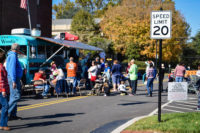
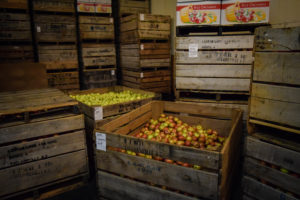 neral direction, and we were met face-to-face with Lindsay Deal: the man behind every aspect of the growing, harvesting and marketing for one of the largest, and oldest, apple orchards in North Carolina. His face was colored initially skeptical, noticeably sizing us up as outsiders. Upon a brief explanation, however, he was more than compliant to talk about North Carolina culture across the Foothills. He opened that same wooden door he had come through just a few minutes age before, and invited us into his office.
neral direction, and we were met face-to-face with Lindsay Deal: the man behind every aspect of the growing, harvesting and marketing for one of the largest, and oldest, apple orchards in North Carolina. His face was colored initially skeptical, noticeably sizing us up as outsiders. Upon a brief explanation, however, he was more than compliant to talk about North Carolina culture across the Foothills. He opened that same wooden door he had come through just a few minutes age before, and invited us into his office.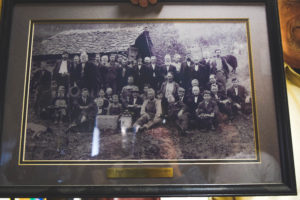 single seller who would then sell their apples to the major grocery chains.
single seller who would then sell their apples to the major grocery chains. 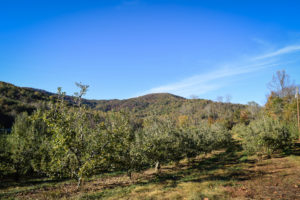 ’s competition has tapered out over the years, leaving just three or four primary orchards to spearhead the Foothill markets. Lindsay and his team have their process down to an absolute science and are Good Agriculture Practices-Certified. If you find yourself traveling through Alexander County, be sure to stop by the Deal Apple House and get a taste of what this family’s combination of passion and expertise has produced.
’s competition has tapered out over the years, leaving just three or four primary orchards to spearhead the Foothill markets. Lindsay and his team have their process down to an absolute science and are Good Agriculture Practices-Certified. If you find yourself traveling through Alexander County, be sure to stop by the Deal Apple House and get a taste of what this family’s combination of passion and expertise has produced.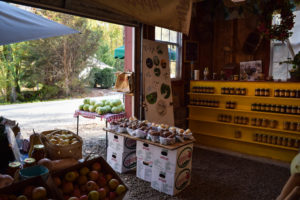 s of apples, each labeled in the same cursive handwriting. Above them lies an entire wall of cowboy hats in every color you imaginable. To the left appears about every type of butter and jam known to man, each in the same gold-lidded mason jar. The place gave me that same feeling I get in my grandmother’s attic, cluttered yet somehow everything seems to hold some sort of memory or value.
s of apples, each labeled in the same cursive handwriting. Above them lies an entire wall of cowboy hats in every color you imaginable. To the left appears about every type of butter and jam known to man, each in the same gold-lidded mason jar. The place gave me that same feeling I get in my grandmother’s attic, cluttered yet somehow everything seems to hold some sort of memory or value. 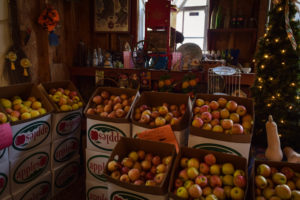 Chicago local.
Chicago local. 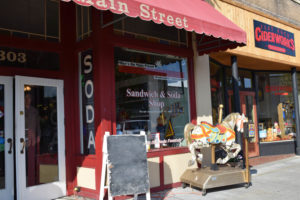 h register. A young waiter dressed in a light blue bow tie and old-fashioned paper hat hurries past, his arms precariously balanced with food. He smiled and sent off a, “Sit where you like,” in passing.
h register. A young waiter dressed in a light blue bow tie and old-fashioned paper hat hurries past, his arms precariously balanced with food. He smiled and sent off a, “Sit where you like,” in passing. 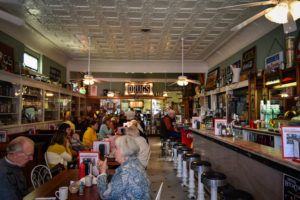 owns and put in orders for some piping hot coffee.
owns and put in orders for some piping hot coffee. 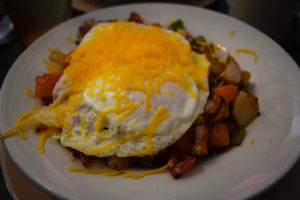 fter a short wait, while no room for disappointment. The general concept of Mike’s breakfast bowls begins with your choice of a hash brown or grits base. Next comes two eggs prepared to your liking, fried comes highly recommended, and then finally a last layer of whatever toppings come with the bowl of your choosing. The Denver bowl is garnished with ham, tomatoes, green pepper, onions and a whole lot of cheddar cheese. The flavors of the dish are perfectly proportioned, neither too overpowering or understated, achieving a perfect point of content fullness–that is, pre-pancakes, browned to perfection and fluffy like you can only find at a diner. A return visit to Hendersonville Mike’s pancakes will definitely be at the top of Hendersonville’s to-eat list.
fter a short wait, while no room for disappointment. The general concept of Mike’s breakfast bowls begins with your choice of a hash brown or grits base. Next comes two eggs prepared to your liking, fried comes highly recommended, and then finally a last layer of whatever toppings come with the bowl of your choosing. The Denver bowl is garnished with ham, tomatoes, green pepper, onions and a whole lot of cheddar cheese. The flavors of the dish are perfectly proportioned, neither too overpowering or understated, achieving a perfect point of content fullness–that is, pre-pancakes, browned to perfection and fluffy like you can only find at a diner. A return visit to Hendersonville Mike’s pancakes will definitely be at the top of Hendersonville’s to-eat list.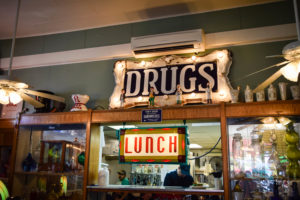
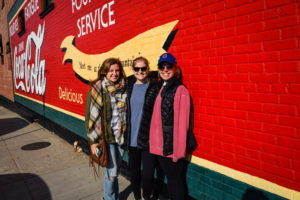
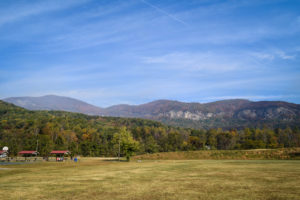 across abandoned-looking towns, and several fruit stands, you will see the scen e emerge from around the bend: the infamous Lake Lure, zig-zagging around rugged mountain ranges.
across abandoned-looking towns, and several fruit stands, you will see the scen e emerge from around the bend: the infamous Lake Lure, zig-zagging around rugged mountain ranges. Lake Lure’s public garden, passing couples holding hands and babies in strollers–caught in the aura of simple contentedness. An aerial view of the lake exposes a quiet gazebo in the distance that looks out to one of the most beautiful views along Highway 64. The contrast between the mountains and lake may remind you of the changing North Carolina landscape along Highway 64, shifting between the coastal plains, foothills, and mountains.
Lake Lure’s public garden, passing couples holding hands and babies in strollers–caught in the aura of simple contentedness. An aerial view of the lake exposes a quiet gazebo in the distance that looks out to one of the most beautiful views along Highway 64. The contrast between the mountains and lake may remind you of the changing North Carolina landscape along Highway 64, shifting between the coastal plains, foothills, and mountains.  he lake. Rather than imagining yourself on the set of
he lake. Rather than imagining yourself on the set of 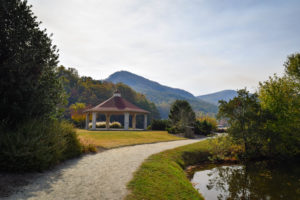 n nature. Perhaps take one last look back at the mountains, soon to return behind you. A pillow of smoke catches your eye, curling from the top of the mountain in a small patch.
n nature. Perhaps take one last look back at the mountains, soon to return behind you. A pillow of smoke catches your eye, curling from the top of the mountain in a small patch. 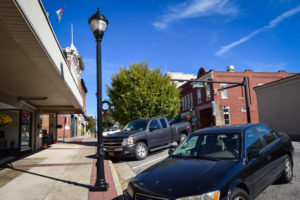 s a rich taste of North Carolina history and tradition. Yet the expectation of the town on a Sunday late afternoon–everyone would be leaving church, taking the dog for a walk, or going to lunch on their day off–was disrupted by a quite different reality.
s a rich taste of North Carolina history and tradition. Yet the expectation of the town on a Sunday late afternoon–everyone would be leaving church, taking the dog for a walk, or going to lunch on their day off–was disrupted by a quite different reality.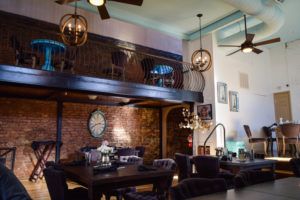 oughout the street from a series of unseen speakers. The music could be described as a marriage of jazz piano and elevator music, perhaps meant to be a nice backdrop to the sounds of engines and human voices. The bizarre ambience, one reminiscent of a post-disillusioned movie, would still not be the main source of disappointment in Lenoir. The greatest disappointment offered by a quiet Sunday in this town, is that a walk along the main street revealed Lenoir has a lot to offer. Amongst a few cafes, the town’s GOP headquarters, and small markets, it seemed every other storefront was an art gallery or antique shop–both retailers for town character, personality, history, and secrets. In an eclectic collection of castaway personal belongings and artistic expression, these are the shops that give define Lenoir local flavor. The storefront windows were decorated with autumnal displays, from puppets, to art easels made of birch branches, to leaves and twigs perched with fake birds. Yet each was closed. Not a single site was open. Walks around square blocks, the real estate turning to banks and insurance fronts the farther the sidewalk talks you the center of town, and a feeling of defeat sinks into the sunny day.
oughout the street from a series of unseen speakers. The music could be described as a marriage of jazz piano and elevator music, perhaps meant to be a nice backdrop to the sounds of engines and human voices. The bizarre ambience, one reminiscent of a post-disillusioned movie, would still not be the main source of disappointment in Lenoir. The greatest disappointment offered by a quiet Sunday in this town, is that a walk along the main street revealed Lenoir has a lot to offer. Amongst a few cafes, the town’s GOP headquarters, and small markets, it seemed every other storefront was an art gallery or antique shop–both retailers for town character, personality, history, and secrets. In an eclectic collection of castaway personal belongings and artistic expression, these are the shops that give define Lenoir local flavor. The storefront windows were decorated with autumnal displays, from puppets, to art easels made of birch branches, to leaves and twigs perched with fake birds. Yet each was closed. Not a single site was open. Walks around square blocks, the real estate turning to banks and insurance fronts the farther the sidewalk talks you the center of town, and a feeling of defeat sinks into the sunny day.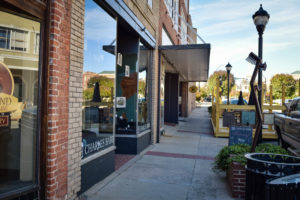 one finds Charlie’s Pub. It seemed the Pub shared the same menu as the Bistro, but with a different wood-panel and booth atmosphere. A table at the back of the restaurant sat regally, occupied by a family of 10+ dressed up in what looked to be church gear as a long table. Off to the side sat a priest and two elderly women, dressed to the nines, sharing lunch and forkfuls of pie.
one finds Charlie’s Pub. It seemed the Pub shared the same menu as the Bistro, but with a different wood-panel and booth atmosphere. A table at the back of the restaurant sat regally, occupied by a family of 10+ dressed up in what looked to be church gear as a long table. Off to the side sat a priest and two elderly women, dressed to the nines, sharing lunch and forkfuls of pie.